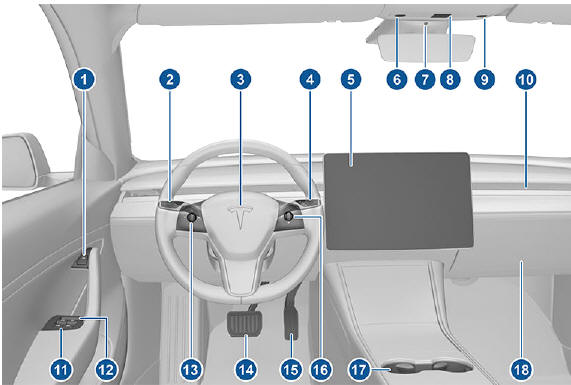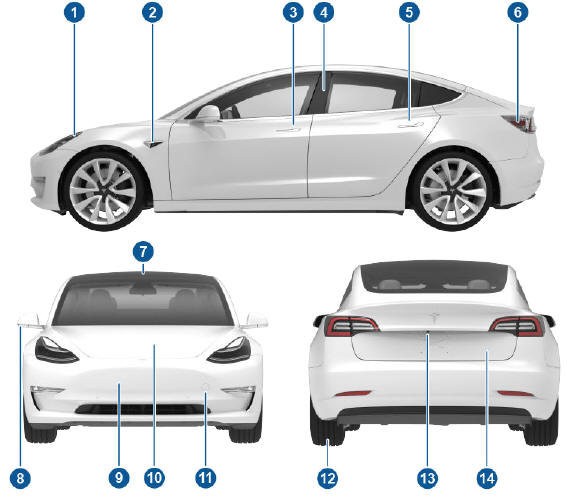Tesla Model 3: Interior Overview & Exterior Overview
Tesla Model 3 2017-2026 Owner's Manual / Overview / Interior Overview & Exterior Overview
Interior Overview

- Door open button
- High beams, turn signals and wipers and washers
- Horn
- Gear selector, Traffic-Aware Cruise Control and Autosteer
- Touchscreen
- Driver dome light
- Cabin camera
- Hazard warning flashers
- Passenger dome light
- Climate control vent
- Power window switches
- Manual door release
- Left scroll button
- Brake pedal
- Accelerator pedal
- Right scroll button
- Center console
- Glovebox
Exterior Overview

- Exterior lights
- Autopilot camera
- Front door handle
- Key card sensor, Autopilot camera
- Rear door handle
- Charge port
- Autopilot cameras
- Exterior mirrors
- Radar sensor (hidden from view)
- Hood/front trunk
- Tow eye cover
- Wheels and tires
- Rear view camera
- Rear trunk
READ NEXT:
 Touchscreen Overview
Touchscreen Overview
The features and information you need to drive Model 3 are displayed on the touchscreen. When driving, the touchscreen displays driving-related information such as driving speed, vehicle range, warn
 Opening and Closing
Opening and Closing
This section contains detailed instructions on how to operate the various components of the Tesla Model 3. It covers important things such as keys, doors, trunk, windows, sunroof and glass roof, child
 Keys
Keys
Three Types of Keys
Model 3 supports three types of keys:
Authenticated phone - You can set up
your personal smartphone to
communicate with Model 3 using
Bluetooth. Supports automatic lockin
SEE MORE:
 Easter Eggs
Easter Eggs
But wait, there's more! Below is a list of the Easter Eggs that have been
discovered so far and how
to access them. Alternatively, touch the Tesla "T" (top center of the
touchscreen) then drag the
About Your Tesla box downwards for one-touch access to all discovered Easter
Eggs
 Reflex Lens - Rear - RH (Remove and Replace)
Reflex Lens - Rear - RH (Remove and Replace)
Remove
Note: This procedure applies only to the RH side. The LH rear
reflex lens is part of the charge port.
Apply masking around the RH rear reflex lens.
Use a plastic trim tool to release the clips that attach the RH rear
reflex lens to the body, and then remove the RH rear reflex lens f
© 2019-2026 Copyright www.tmodel3.com

